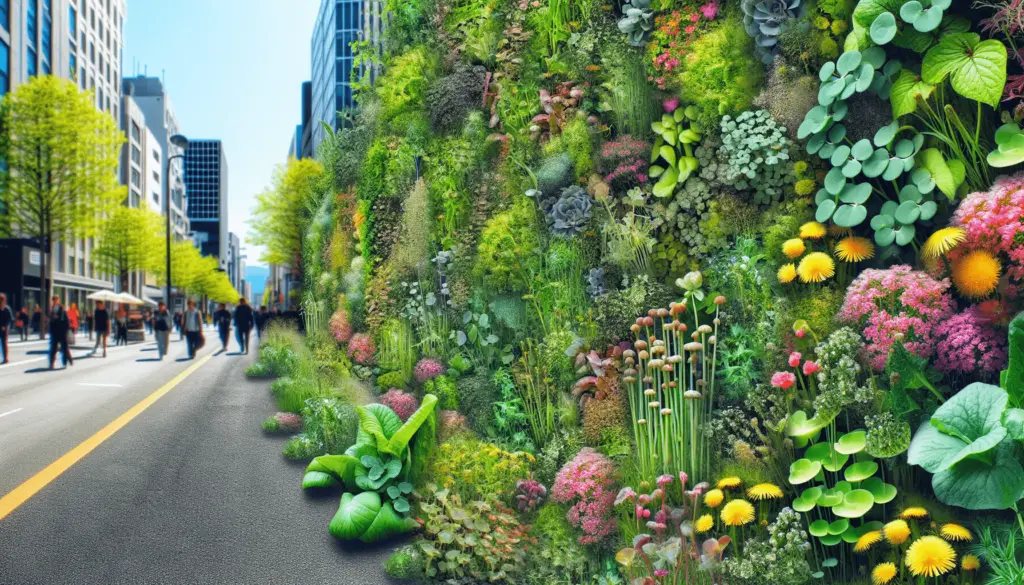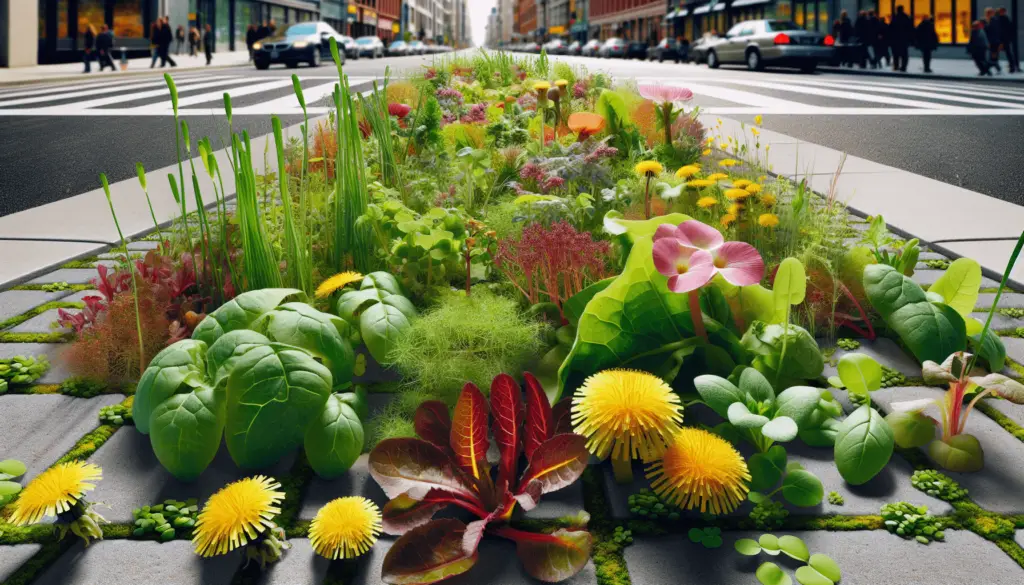Welcome to the exciting world of urban foraging! In this article, you will learn some essential tips for finding food in the city. From discovering hidden fruit trees in your neighborhood to scoping out community gardens, you will soon become a pro at sourcing fresh, local produce right in your own urban jungle. So grab your basket and get ready to explore the abundance of edible treasures that await you in the city! Have you ever wondered how you can find food in the city without having to rely solely on grocery stores and restaurants? Urban foraging is a growing trend that allows you to discover edible plants and foods right in your own urban environment. In this article, we will provide you with essential tips for mastering the art of urban foraging so you can enjoy the unique experience of finding food in the city.

Getting Started with Urban Foraging
When you first start urban foraging, it can be overwhelming to know where to begin. The key is to start small and gradually expand your knowledge and skills. Begin by familiarizing yourself with the edible plants that grow in your area and slowly build your confidence. Remember to always forage responsibly and ethically to protect the environment and ensure the sustainability of your foraging spots.
Researching Edible Plants in Your Area
One of the first steps in urban foraging is to research the edible plants that grow in your city. Look for field guides, online resources, and local foraging groups to learn more about the plants that are safe to eat. Make sure to properly identify plants before consuming them to avoid any potential health risks.
Starting with Common Edible Plants
As a beginner, it’s a good idea to start with common edible plants that are easy to identify and harvest. Some common urban foraging plants include dandelions, plantain, chickweed, and purslane. These plants are often found in parks, sidewalks, and other urban areas, making them accessible for beginners.
Essential Tips for Urban Foraging
Urban foraging comes with its own set of challenges and considerations. These essential tips will help you navigate the cityscape and find food safely and sustainably.
Know the Laws and Regulations
Before you start urban foraging, make sure to familiarize yourself with the laws and regulations regarding foraging in your city. Some areas may have restrictions on foraging in certain parks or public spaces, so it’s important to respect these rules to avoid any legal issues.
Avoid Contaminated Areas
When foraging in urban environments, it’s crucial to avoid areas that may be contaminated with pollutants or chemicals. Stay away from plants growing near busy roads, industrial sites, or areas that are sprayed with pesticides. Choose clean, unpolluted areas for foraging to ensure the safety of the food you harvest.
Use Proper Foraging Tools
Having the right tools can make your urban foraging experience more effective and enjoyable. Invest in a good field guide, a pair of gloves, a small basket or bag for collecting plants, and a pair of scissors or shears for harvesting. These tools will help you identify plants, protect your hands, and gather your harvest without damaging the plants.
Practice Sustainable Foraging
Sustainability is key when it comes to urban foraging. Only harvest what you need and leave enough plants behind to ensure their continued growth and reproduction. Be mindful of the environment and avoid overharvesting in one area. By practicing sustainable foraging, you can help preserve urban ecosystems and ensure future foraging opportunities.
Identifying Edible Plants
Properly identifying edible plants is essential for a successful urban foraging experience. Here are some tips to help you identify edible plants in the city.
Characteristics of Edible Plants
When identifying edible plants, look for certain characteristics that can help you distinguish them from non-edible plants. Edible plants often have simple leaves, small white or yellow flowers, and an overall “weedy” appearance. Familiarize yourself with these characteristics to make foraging easier and safer.
Using Field Guides and Apps
Field guides and foraging apps can be valuable resources for identifying edible plants in the city. Look for guides specific to your region to help you learn more about the plants that grow in your area. Some foraging apps even use photo recognition technology to help you identify plants on the go.
Joining Foraging Groups
Joining a local foraging group or attending a foraging workshop can provide you with hands-on experience and guidance on identifying edible plants. These groups often have experienced foragers who can teach you how to properly identify plants, as well as share tips and tricks for successful foraging in the city.
Common Edible Plants Found in Urban Areas
Urban environments are full of edible plants that you can harvest for food. Here are some common edible plants found in cities that you can start with.
Dandelion
Dandelions are one of the most well-known edible plants found in urban areas. The entire plant is edible, from the roots to the flowers. Dandelion greens can be used in salads, while the flowers can be made into dandelion wine or tea. Look for dandelions in parks, lawns, and other open spaces.
Chickweed
Chickweed is a common edible plant that is often found in moist, shady areas. The leaves of chickweed have a mild, slightly sweet flavor and can be used in salads, soups, and stir-fries. Chickweed is easy to identify by its small, star-shaped flowers and delicate leaves.
Purslane
Purslane is a nutritious edible plant that is rich in omega-3 fatty acids and antioxidants. The succulent leaves of purslane have a slightly tangy flavor and can be eaten raw or cooked. Look for purslane growing in cracks in the sidewalk, garden beds, or other sunny locations.
Plantain
Plantain is a versatile edible plant that can be found in urban areas throughout the year. The leaves of plantain are high in vitamins A and C and can be used in salads, soups, and as a natural remedy for insect bites and minor wounds. Plantain is easily identified by its broad, ribbed leaves and tall flower stalk.

Safety Considerations for Urban Foraging
While urban foraging can be a rewarding experience, it’s important to prioritize safety and take certain precautions to avoid any potential risks. Here are some safety considerations to keep in mind when foraging in the city.
Avoid Toxic Plants
One of the most critical safety considerations when foraging is to avoid toxic plants that can be harmful if consumed. Familiarize yourself with common toxic plants in your area and learn how to distinguish them from edible plants. When in doubt, do not consume a plant unless you are absolutely certain of its identity.
Practice Proper Hygiene
When foraging in urban areas, be mindful of potential contaminants on the plants you harvest. Wash all harvested plants thoroughly before consuming them to remove any dirt, pollutants, or chemicals that may be present. Practice proper hygiene by washing your hands before and after handling plants to reduce the risk of foodborne illness.
Be Aware of Allergies
If you have allergies to certain plants or foods, be cautious when trying new edible plants in the city. Start by consuming small amounts of a plant to test for any adverse reactions before incorporating it into your diet. If you experience any symptoms of an allergic reaction, such as itching, swelling, or difficulty breathing, seek medical attention immediately.
Urban Foraging Etiquette
As a responsible forager, it’s essential to follow proper etiquette when gathering food in the city. By respecting the environment and other foragers, you can help preserve urban foraging spots and promote a sense of community among fellow foragers.
Leave No Trace
When foraging in urban areas, it’s crucial to leave no trace behind to minimize your impact on the environment. Avoid damaging plants or their surroundings when harvesting, and always clean up after yourself by properly disposing of any waste or packaging. By practicing Leave No Trace principles, you can help maintain the natural beauty of urban foraging spots.
Respect Private Property
Respect the boundaries of private property when foraging in the city to avoid trespassing or causing any conflicts with property owners. Always ask for permission before harvesting plants on private land, and be mindful of any restrictions or guidelines set by the property owner. By respecting private property rights, you can cultivate positive relationships with the community and ensure continued foraging opportunities.
Share Knowledge and Resources
Part of the joy of urban foraging is sharing knowledge and resources with fellow foragers. If you come across a particularly bountiful harvest or discover a new foraging spot, consider sharing your findings with others. Joining online foraging groups or attending community events can also provide you with opportunities to connect with like-minded individuals and expand your foraging network.
Conclusion
Urban foraging is a rewarding and sustainable way to connect with the natural world and discover the abundance of edible plants that grow right in your own city. By following these essential tips and safety considerations, you can master the art of urban foraging and enjoy a unique and fulfilling experience finding food in the city. Remember to forage responsibly, respect the environment, and share your knowledge with others to foster a sense of community and camaraderie among urban foragers. Happy foraging!
